Personal protective equipment (PPE) manufacturers are continually refining and improving the helmets and eye protection they make that are used in structural firefighting and rescue situations.
Mitch Soman, marketing manager for MSA Cairns, says Cairns makes fire helmets for every type of need. Soman notes the Cairns® N5A New Yorker™ leather fire helmet is handcrafted, shaped, stitched, and trimmed to provide advanced thermal impact and penetration protection and features replaceable soft goods that are easy to remove and clean. “Our most popular model is the Cairns 1044 traditional composite fire helmet constructed from through-color fiberglass composite material with a matte finish design that resists cracking and chipping, ” Soman says. He notes that a patented shell release system retains the impact cap if the helmet is torn off during an incident, shielding the firefighter from heat, debris, and projectiles. Both models are available with an external face shield, Bourkes clear flip-downs, or goggles.
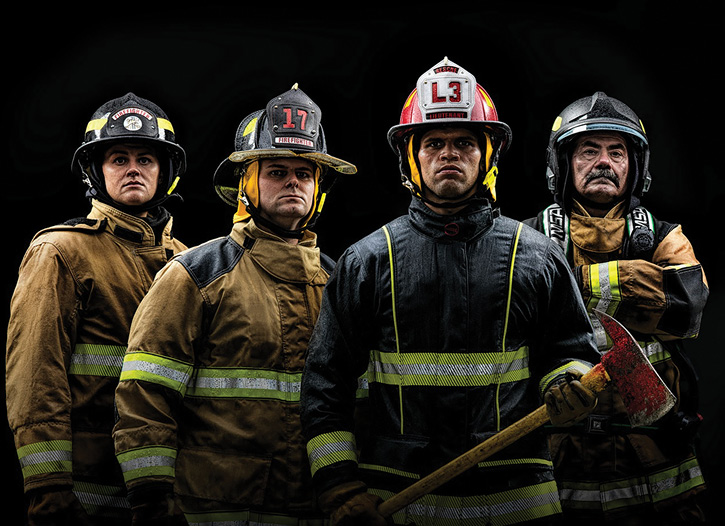
1 MSA Cairns makes a variety of fire helmets, including, from left, the 660C Metro, the N5A Leather New Yorker, the 1044 traditional composite, and the XF1 fire helmet. (Photo 1 courtesy of MSA Cairns.)
Cairns also makes the 660C Metro™ composite fire helmet, says John Ramsey, product line manager. Ramsey points out that the 660C Metro is tough enough for structural or proximity firefighting, light enough for technical rescue, and small enough for emergency medical services (EMS) and confined space applications. “It’s available with the retractable Defender visor, which can be easily raised or lowered with a gloved hand,” he says. Cairns also makes the 880 traditional thermoplastic fire helmet, the XR2 technical rescue helmet, and the jet-style design XF1 fire helmet.
Soman adds that Cairns is working on a new traditional style fire helmet that it plans to launch some time this year. “This will be the first time since 1991 that we are designing and engineering a new traditional helmet,” he says. “It will differ from current traditional designs as a result of ‘voice of the customer’ meetings where firefighters told us what they want in a new helmet with the big topics being weight, ride height, and ease of disassembly for cleaning.”
Todd Herring, vice president of product innovation and strategy for Fire-Dex, says his company is focused on research and development to make helmets easier to clean and maintain as well as improving weight and balance. Herring says Fire-Dex’s Model 1910 traditional fire helmet has remained a favorite of fire departments around the country. “We make both standard and deluxe models of the Model 1910 with a fiberglass shell, removable head harness for ease of cleaning, and a selection of eye protection,” he notes.
Herring says Fire-Dex’s Model 911 modern helmet embodies a lightweight and sleek look while offering protection. “The Model 911 has a more rounded and streamlined design that provides exceptional flame and heat resistance while offering a comfortable fit for all self-contained breathing apparatus (SCBA),” he points out. “It features upgraded materials and technologies, such as a thermal impact cap insert, which allows the helmet to remain 66% cooler than helmets without it. It’s available with either a drop-down shield or goggles.”
Richard Harris, director of R&D and technical product management for Lion, says his company has been on a drive toward lighter weight helmets and uses new materials to reduce weight. “Our American Legend™ series is our primary traditional profile helmet,” Harris says, “and is the most preferred shell style among users. It’s made of a new material that’s a composite mix of fiberglass, resins, and pigments in a unique formulation that gives high strength, light weight, and a pigment embedded in the composite material.”
He continues, “We are expanding our capacity to fit a wider range of head styles yet still maintain the helmet’s low profile and low center of gravity through its patented suspension system.”
“American Legend is made with “Quick Clean” soft goods that are easy to remove and clean,” Harris says, “and is offered with a full range of eye protection, including flip-downs, an integrated face shield that recesses into the helmet’s dome, a standard face shield, and goggles.”
Lion also makes the American Heritage™ leather helmet with a low profile that has an adjustable multipoint suspension to eliminate wobble and ensure a good fit and the American Legacy™ low-profile modern style fire helmet that has a Center of Gravity™ suspension, a Lexan®/ABS impact cap for impact protection and thermal resistance, and resin transfer molding (RTM) technology to give color pigmentation throughout the shell. The helmet supports a 4-inch face shield or goggles.
Matt Plunkett, principal mechanical engineer for Bullard, says the company makes the UST-LW model, a lightweight traditional style fire helmet made with a fiberglass composite shell and fitted with a proprietary U-Fit headband system with a six-point crown strap and crown pad that provides 36 adjustment settings. The UST-LW also can be had with the optional ReTrak™ Visor, Plunkett adds, as well as TrakLite® integrated lighting that features eight forward-facing and rear buddy LED lights.
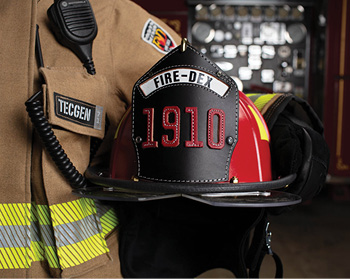
2 Fire-Dex makes the Model 1910 traditional style helmet with a removable head harness and a selection of eye protection. (Photo 2 courtesy of Fire-Dex.)
</div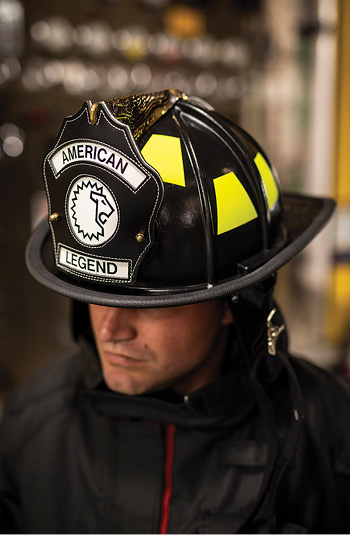
3 Lion’s American Legend traditional profile helmet is made of a new material that’s a composite mix of fiberglass, resins, and pigments. (Photo 3 courtesy of Lion.)

4 Bullard’s LST-LW traditional style helmet is made with a fiberglass composite shell and has a proprietary U-Fit headband system. (Photo 4 courtesy of Bullard.)
Bullard also makes the USRX rescue helmet of the same materials as the UST-LW but in a smaller form factor and is lighter in weight, Plunkett points out. He says it has a low center of gravity, low profile, and a Sure-Lock® ratchet headband with a three-position height adjuster. The USRX is available with flip-down eye lenses, face shields in several versions including radiant coating, and goggles.
Angel Sanchez Jr., director of global operations for Phenix Technology Inc., says Phenix’s First Due structural fire helmet continues to be the company’s most popular helmet in terms of sales volume. The First Due is a modern style helmet with a low center of gravity and central balance, Sanchez says, so it is less likely to create neck and upper back fatigue that comes from long incidents. The helmet has a high-temperature thermoplastic shell, a closed-cell energy impact cap, and a Phenix suspension liner.
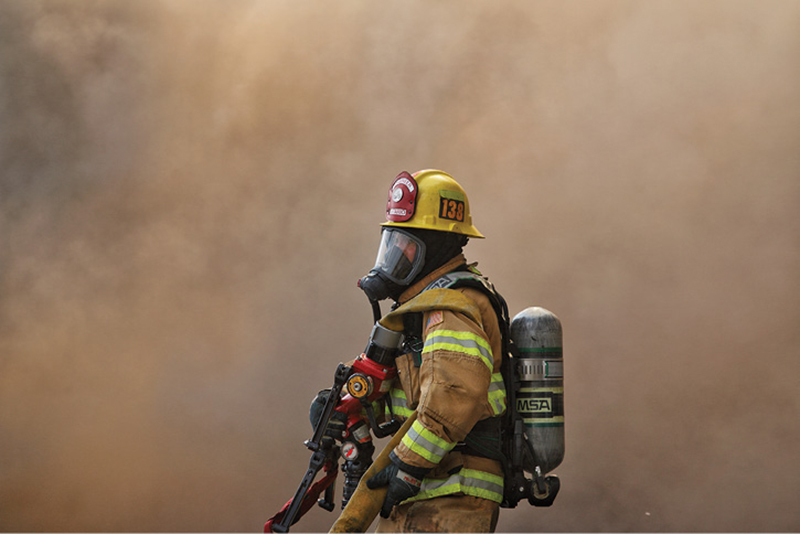
5 Phenix Technology makes the First Due modern style helmet that features a low center of gravity and central balance. (Photo 5 courtesy of Phenix Technology Inc.)
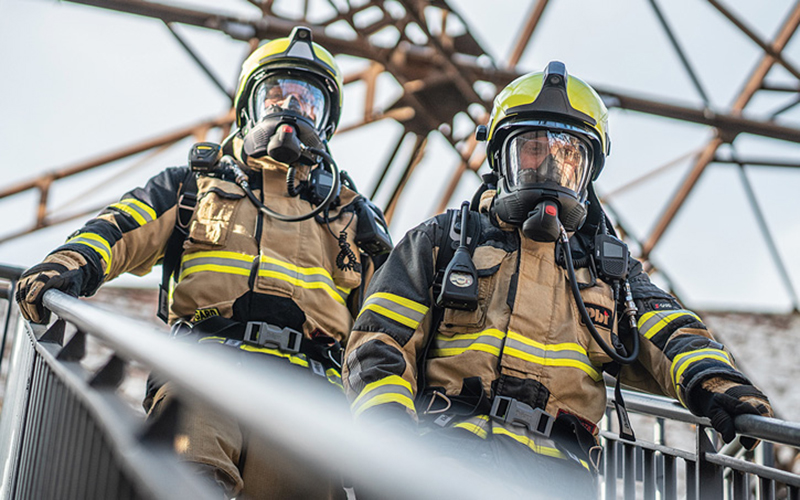
6 Dräger has introduced the HPS SafeGuard helmet weighing 3.2 pounds that is designed to ease the burden on a firefighter’s neck and shoulders. (Photo 6 courtesy of Dräger.)
Sanchez says Phenix has seen tremendous growth in the use of its TL-2 traditional leather fire helmet. “It has a top-grade leather shell with a commemorative 9-11 filigree design, a high-temperature thermoplastic dome, a closed cell energy impact cap, and a Phenix suspension liner. Phenix also makes the TL-2 Miller, its version of F.J. Miller’s original 64-cone corrugated fire hat, and the TC-1 traditional composite helmet that interfaces with any SCBA mask.
Paul Tarter, Dräger’s product manager for North America, says Dräger has introduced the HPS SafeGuard helmet that combines wearing comfort with rigorous safety protection. The HPS SafeGuard weighs 3.2 pounds and is engineered to ease the physical burden on a firefighter’s neck and shoulders, he points out. Tarter adds that because the helmet is compliant with NFPA standards for structural firefighting and technical rescue, it allows firefighters to wear the helmet “in battling house fires, navigating confined spaces, or even performing rope rescues.” The HPS Safeguard comes with reflective strips and a backlit BuddyLight.
ALAN M. PETRILLO is a Tucson, Arizona-based journalist, the author of three novels and five nonfiction books, and a member of the Fire Apparatus & Emergency Equipment Editorial Advisory Board. He served 22 years with the Verdoy (NY) Fire Department, including in the position of chief.

